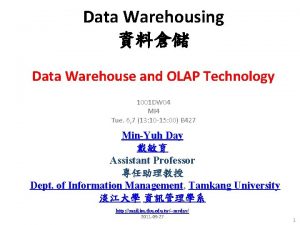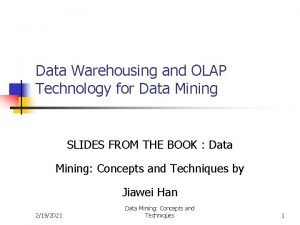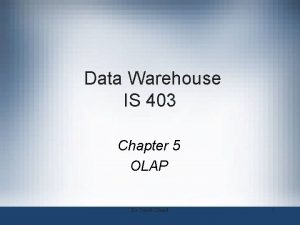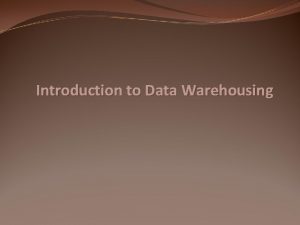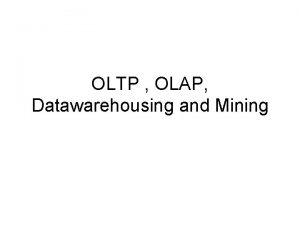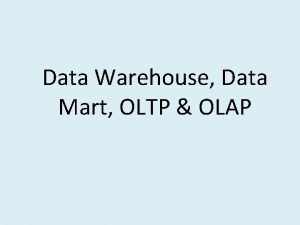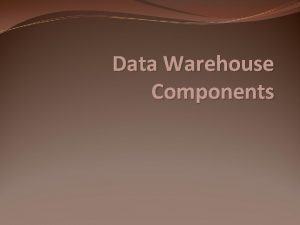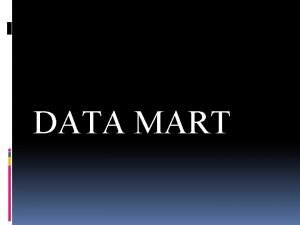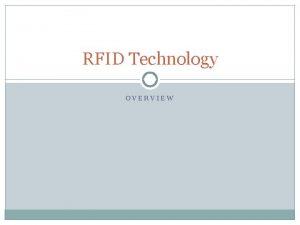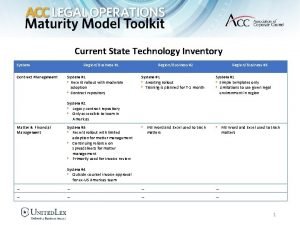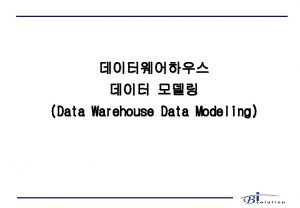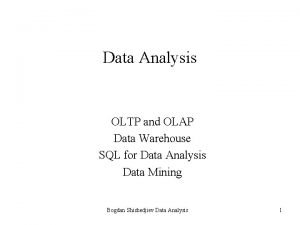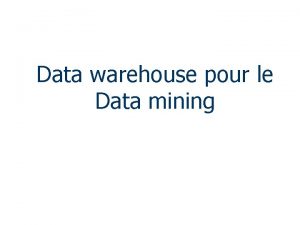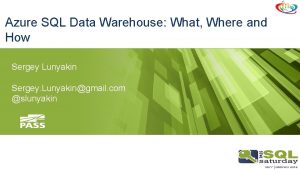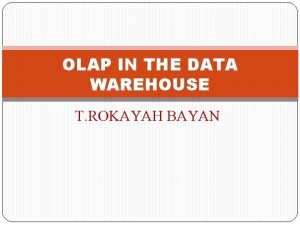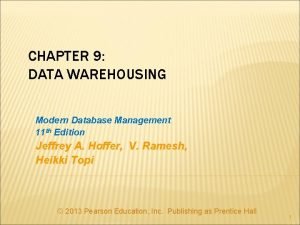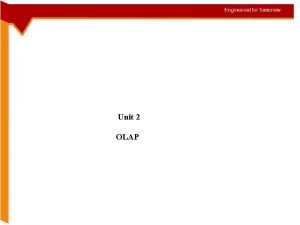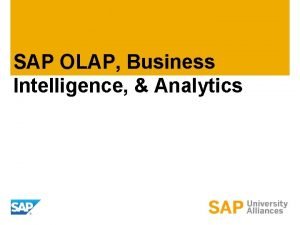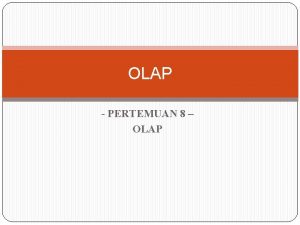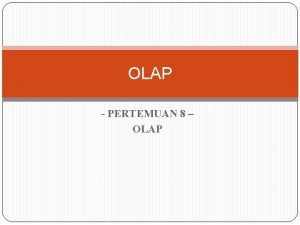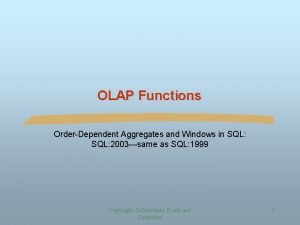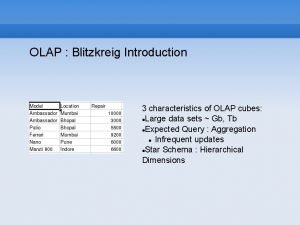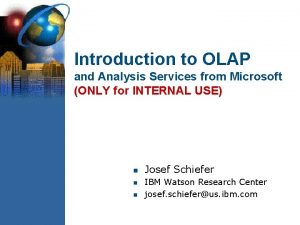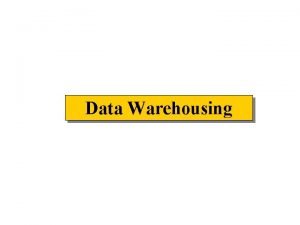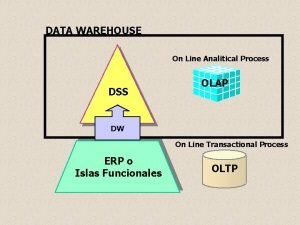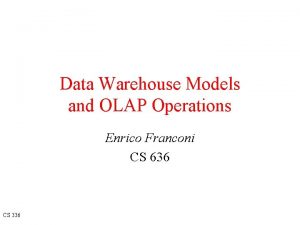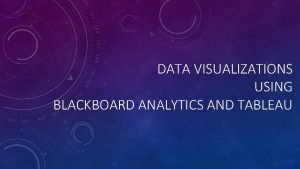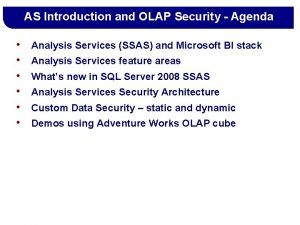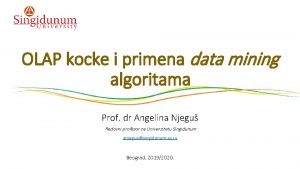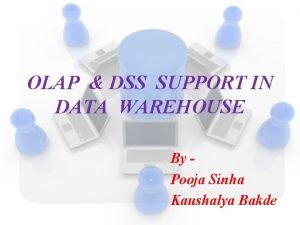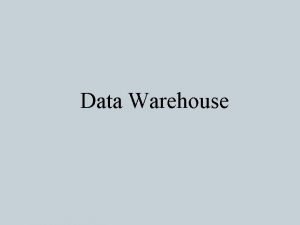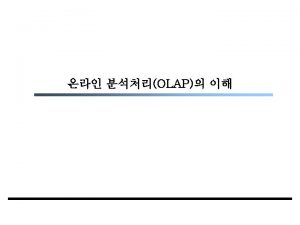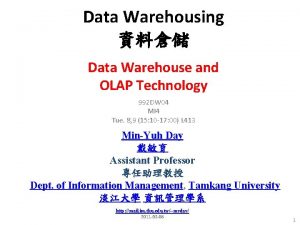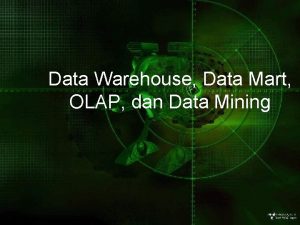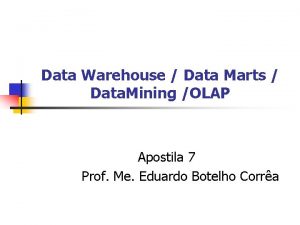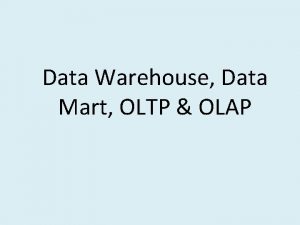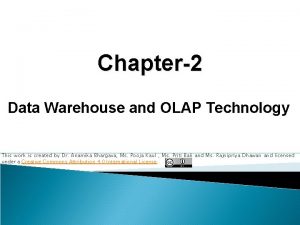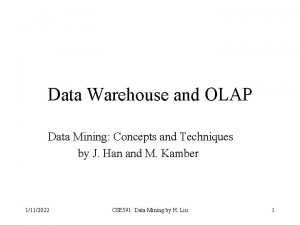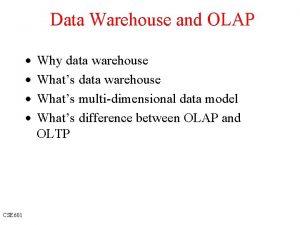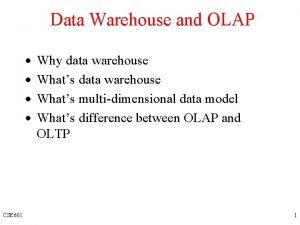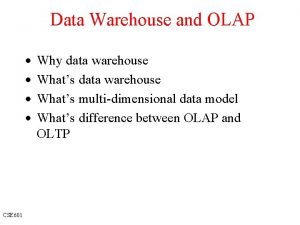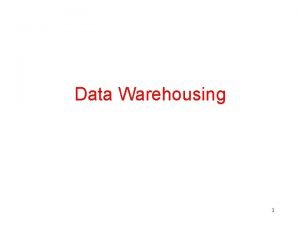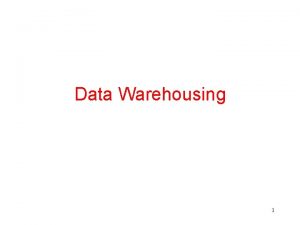Overview of Data Warehouse and OLAP Technology Ch






































![Cube Operation n Cube definition and computation in DMQL define cube sales[item, city, year]: Cube Operation n Cube definition and computation in DMQL define cube sales[item, city, year]:](https://slidetodoc.com/presentation_image/0bb9a9e95b9c9a7d7e9c4247feacb2aa/image-39.jpg)









- Slides: 48

Overview of Data Warehouse and OLAP Technology Ch. 25 Hazem Hajj Source: Data Mining Course Presentations 1

WHY DATA WAREHOUSE? 24 September 2020 Data Mining: Concepts and Techniques 2

Stock Prediction 24 September 2020 Data Mining: Concepts and Techniques 3

from H. Jeong et al Nature 411, 41 (2001) Graph, Everywhere: Hidden Pattern? Aspirin 24 September 2020 Internet Yeast protein interaction network Mining and Searching Graphs in Graph Co-author Databases network 4

Social Network: Community behavior Nodes: individuals Links: social relationship (family/work/friendship/etc. ) S. Milgram (1967) John Guare Social networks: Many individuals with diverse social interactions between them. 24 September 2020 Six Degrees of Separation (also referred to as the "Human Web") refers to the idea that, if a person is one step away from each person they know and two steps away from each person who is known by one of the people they know, then everyone is at most six steps away from any other person on Earth. Data Mining: Concepts and Techniques 5

WEB Search Engine – Two Rank Functions Ranking based on link structure analysis Search Rank Functions Similarity based on content or text Importance Ranking (Link Analysis) Relevance Ranking Backward Link (Anchor Text) Indexer Inverted Index Term Dictionary (Lexicon) Web Topology Graph Anchor Text Generator Meta Data Forward Index Forward Link Web Graph Constructor URL Dictioanry Web Page Parser Web Pages 9/24/2020 Data Mining: Principles and Algorithms 6

Web Mining Web Page Blocks Importance = Low Importance = Med Importance = High 9/24/2020 Data Mining: Principles and Algorithms 7

Knowledge Discovery (KDD) Process n Data mining—core of knowledge discovery process Pattern Evaluation Data Mining Task-relevant Data Selection Data Warehouse Data Cleaning Data Integration Databases 24 September 2020 Data Mining: Concepts and Techniques 8

Architecture: Typical Data Mining System Graphical User Interface Pattern Evaluation OLAP Data Mining Engine Knowl edge. Base Database or Data Warehouse Server data cleaning, integration, and selection Database 24 September 2020 Data World-Wide Other Info Repositories Warehouse Web Data Mining: Concepts and Techniques 9

Data Warehousing and OLAP Technology: An Overview n What is a data warehouse? : Definition, OLAP VS OLTP, n A multi-dimensional data model n Data warehouse architecture n Data warehouse implementation n From data warehousing to data mining 24 September 2020 Data Mining: Concepts and Techniques 10

What is Data Warehouse? n “A data warehouse is a subject-oriented, integrated, time-variant, and nonvolatile collection of data in support of management’s decision-making process. ”—W. H. Inmon 24 September 2020 Data Mining: Concepts and Techniques 11

Data Warehouse—Subject-Oriented n Organized around major subjects, such as sales n (versus operational DB that may be storing every single transaction that happened in a store: time, teller, product items, barcode, price per item, customer info, …) n Focusing on the modeling and analysis of data for decision makers, n not on daily operations or transaction processing (e. g. : sales/year, sales/branch, …. ) 24 September 2020 Data Mining: Concepts and Techniques 12

Data Warehouse—Integrated n n Constructed by integrating multiple, heterogeneous data sources n relational databases, flat files, on-line transaction records Data cleaning and data integration techniques are applied. n Ensure consistency among different data sources n n E. g. , Hotel price: currency, tax, breakfast covered, etc. When data is moved to the warehouse, it is converted. 24 September 2020 Data Mining: Concepts and Techniques 13

Data Warehouse—Time Variant n The time horizon for the data warehouse is significantly longer than that of operational systems n n Data warehouse data: provide information from a historical perspective (e. g. , past 5 -10 years) Every key structure in the data warehouse Contains an element of time, explicitly or implicitly 24 September 2020 Data Mining: Concepts and Techniques 14

Data Warehouse—Nonvolatile n A physically separate store of data transformed from the operational environment n Requires two operations in data accessing: n 24 September 2020 loading of data and access of data Data Mining: Concepts and Techniques 15

Data Warehouse vs. Heterogeneous DBMS n Traditional heterogeneous DB integration: A query driven approach n When a query is posed to a client site, a meta-dictionary is used to translate the query into queries appropriate for individual heterogeneous sites involved, and the results are integrated into a global answer set n Data warehouse: update-driven, high performance n Information from heterogeneous sources is integrated in advance and stored in warehouses for direct query and analysis 24 September 2020 Data Mining: Concepts and Techniques 16

Data Warehouse vs. Operational DBMS n OLTP (on-line transaction processing) n Major task of traditional relational DBMS n Day-to-day operations. n n n Example at Intel: OLTP stores equipment and wafer data. (Not overall process health) OLAP (on-line analytical processing) n Major task of data warehouse system n Data analysis and decision making n Example at Intel: WIPT (Wip Turns) Distinct features (OLTP vs. OLAP): n Data contents: current, detailed vs. historical, consolidated n Database design: ER vs. star + subject 24 September 2020 Data Mining: Concepts and Techniques 17

OLTP vs. OLAP 24 September 2020 Data Mining: Concepts and Techniques 18

Data Warehousing and OLAP Technology: An Overview n What is a data warehouse? n A multi-dimensional data model: Schema design, Cubes, and typical OLAP n Data warehouse architecture n Data warehouse implementation n From data warehousing to data mining 24 September 2020 Data Mining: Concepts and Techniques 19

From Tables and Spreadsheets to Data Cubes n A data warehouse is based on a multidimensional data model which views data in the form of a data cube n A data cube, such as sales, allows data to be modeled and viewed in multiple dimensions n Dimension tables, such as item (item_name, brand, type), or time(day, week, month, quarter, year) n Fact table contains measures (such as dollars_sold) and keys to each of the related dimension tables n In data warehousing literature, an n-D base cube is called a base cuboid. The top most 0 -D cuboid, which holds the highest-level of summarization, is called the apex cuboid. The lattice of cuboids forms a data cube. 24 September 2020 Data Mining: Concepts and Techniques 20

Cube: A Lattice of Cuboids Aggregation with GROUP BY all time 0 -D(apex) cuboid item time, location time, item location item, location time, supplier location, supplier item, supplier time, location, supplier time, item, location time, item, supplier 1 -D cuboids 2 -D cuboids 3 -D cuboids item, location, supplier 4 -D(base) cuboid time, item, location, supplier 24 September 2020 Data Mining: Concepts and Techniques 21

Conceptual Modeling of Data Warehouses n Modeling data warehouses: dimensions & measures n Star schema: A fact table in the middle connected to a set of dimension tables n Snowflake schema: A refinement of star schema where some dimensional hierarchy is normalized into a set of smaller dimension tables, forming a shape similar to snowflake n Fact constellations: Multiple fact tables share dimension tables, viewed as a collection of stars, therefore called galaxy schema or fact constellation 24 September 2020 Data Mining: Concepts and Techniques 22

Example of Star Schema time item time_key day_of_the_week month quarter year Sales Fact Table time_key item_key branch_key branch_name branch_type location_key units_sold dollars_sold avg_sales item_key item_name brand type supplier_type location_key street city state_or_province country Measures 24 September 2020 Data Mining: Concepts and Techniques 23

Example of Snowflake Schema time_key day_of_the_week month quarter year item Sales Fact Table time_key item_key branch location_key branch_name branch_type units_sold dollars_sold avg_sales Measures 24 September 2020 Data Mining: Concepts and Techniques item_key item_name brand type supplier_key supplier_type location_key street city_key city state_or_province country 24

Example of Fact Constellation time_key day_of_the_week month quarter year item Sales Fact Table time_key item_key item_name brand type supplier_type location_key branch_name branch_type units_sold dollars_sold avg_sales item_key shipper_key location to_location_key street city province_or_state country dollars_cost Measures 24 September 2020 time_key from_location branch_key branch Shipping Fact Table Data Mining: Concepts and Techniques units_shipped shipper_key shipper_name location_key shipper_type 25

Multidimensional Data Sales volume as a function of product, month, and region Dimensions: Product, Location, Time Hierarchical summarization paths gi on n Re Industry Region Year Product Category Country Quarter Product City Office Month Week Day Month 24 September 2020 Data Mining: Concepts and Techniques 26

2 Qtr 3 Qtr 4 Qtr sum od TV PC VCR sum 1 Qtr Date Total annual sales of TV in U. S. A. Pr U. S. A Canada Mexico Country uc t A Sample Data Cube sum 24 September 2020 Data Mining: Concepts and Techniques 27

Cuboids Corresponding to the Cube all 0 -D(apex) cuboid product, date country product, country 1 -D cuboids date, country 2 -D cuboids product, date, country 24 September 2020 Data Mining: Concepts and Techniques 3 -D(base) cuboid 28

Browsing a Data Cube n n n 24 September 2020 Visualization OLAP capabilities Interactive manipulation Data Mining: Concepts and Techniques 29

Typical OLAP Operations n Roll up (drill-up): summarize data n n by climbing up hierarchy or by dimension reduction Drill down (roll down): reverse of roll-up from higher level summary to lower level summary or detailed data, or introducing new dimensions Slice and dice: slice: select on one dimension of the cube; dice: select on two or more dimensions. n n n Pivot (rotate): n n reorient the cube, visualization, 3 D to series of 2 D planes Other operations n n drill across: involving (across) more than one fact table drill through: through the bottom level of the cube to its back-end relational tables (using SQL) 24 September 2020 Data Mining: Concepts and Techniques 30

Fig. 3. 10 Typical OLAP Operations 24 September 2020 Data Mining: Concepts and Techniques 31

Data Warehousing and OLAP Technology: An Overview n What is a data warehouse? n A multi-dimensional data model n Data warehouse System architecture, Development approach and Back-end tools n Data warehouse implementation n From data warehousing to data mining 24 September 2020 Data Mining: Concepts and Techniques 32

Data Warehouse: A Multi-Tiered Architecture Other sources Operational DBs Metadata Extract Transform Load Refresh Monitor & Integrator Data Warehouse OLAP Server Serve Analysis Query Reports Data mining Data Marts Data Sources 24 September 2020 Data Storage OLAP Engine Front-End Tools Data Mining: Concepts and Techniques 33

Three Data Warehouse Models n n n Enterprise warehouse n collects all of the information about subjects spanning the entire organization Data Mart n a subset of corporate-wide data that is of value to a specific groups of users. Its scope is confined to specific, selected groups, such as marketing data mart Virtual warehouse n A set of views over operational databases n Only some of the possible summary views may be materialized 24 September 2020 Data Mining: Concepts and Techniques 34

Data Warehouse Development: A Recommended Approach Multi-Tier Data Warehouse Distributed Data Marts Data Mart Model refinement Enterprise Data Warehouse Model refinement Define a high-level corporate data model 24 September 2020 Data Mining: Concepts and Techniques 35

Data Warehouse Back-End Tools and Utilities n n n Data extraction n get data from multiple, heterogeneous, and external sources Data cleaning n detect errors in the data and rectify them when possible Data transformation n convert data from legacy or host format to warehouse format Load n sort, summarize, consolidate, compute views, check integrity, and build indicies and partitions Refresh n propagate the updates from the data sources to the warehouse 24 September 2020 Data Mining: Concepts and Techniques 36

Data Warehousing and OLAP Technology: An Overview n What is a data warehouse? n A multi-dimensional data model n Data warehouse architecture n Data warehouse implementation: Efficient Cube computations n From data warehousing to data mining 24 September 2020 Data Mining: Concepts and Techniques 37

Efficient Data Cube Computation n Data cube can be viewed as a lattice of cuboids n The bottom-most cuboid is the base cuboid n The top-most cuboid (apex) contains only one cell n n How many cuboids in an n-dimensional cube with L levels? Materialization of data cube n n Materialize every (cuboid) (full materialization), none (no materialization), or some (partial materialization) Selection of which cuboids to materialize n 24 September 2020 Based on size, sharing, access frequency, etc. Data Mining: Concepts and Techniques 38
![Cube Operation n Cube definition and computation in DMQL define cube salesitem city year Cube Operation n Cube definition and computation in DMQL define cube sales[item, city, year]:](https://slidetodoc.com/presentation_image/0bb9a9e95b9c9a7d7e9c4247feacb2aa/image-39.jpg)
Cube Operation n Cube definition and computation in DMQL define cube sales[item, city, year]: sum(sales_in_dollars) compute cube sales n Transform it into a SQL-like language (with a new operator cube by, introduced by Gray et al. ’ 96) () SELECT item, city, year, SUM (amount) (city) FROM SALES n CUBE BY item, city, year Need compute the following Group-Bys (city, item) (city, year) (date, product, customer), (date, product), (date, customer), (product, customer), (city, item, year) (date), (product), (customer) () 24 September 2020 Data Mining: Concepts and Techniques (year) (item, year) 39

Iceberg Cube n Computing only the cuboid cells whose count or other aggregates satisfying the condition like HAVING COUNT(*) >= minsup n Motivation n Only a small portion of cube cells may be “above the water’’ in a sparse cube n Only calculate “interesting” cells—data above certain threshold n Avoid explosive growth of the cube n Suppose 100 dimensions, only 1 base cell. How many aggregate cells if count >= 1? What about count >= 2? 24 September 2020 Data Mining: Concepts and Techniques 40

Data Warehousing and OLAP Technology: An Overview n What is a data warehouse? n A multi-dimensional data model n Data warehouse architecture n Data warehouse implementation n From data warehousing to data mining 24 September 2020 Data Mining: Concepts and Techniques 41

Data Warehouse Usage n Three kinds of data warehouse applications n Information processing n n n supports querying, basic statistical analysis, and reporting using crosstabs, tables, charts and graphs Analytical processing n multidimensional analysis of data warehouse data n supports basic OLAP operations, slice-dice, drilling, pivoting Some Data mining n n n 24 September 2020 knowledge discovery from hidden patterns supports associations, constructing analytical models, performing classification and prediction, and presenting the mining results using visualization tools More DM may be needed for complex data or more automated analysis. Data Mining: Concepts and Techniques 42

From On-Line Analytical Processing (OLAP) to On Line Analytical Mining (OLAM) n Why online analytical mining? n High quality of data in data warehouses n DW contains integrated, consistent, cleaned data n Available information processing structure surrounding data warehouses n ODBC, Web accessing, service facilities, reporting and OLAP tools n OLAP-based exploratory data analysis n Mining with drilling, dicing, pivoting, etc. n On-line selection of data mining functions n Integration and swapping of multiple mining functions, algorithms, and tasks 24 September 2020 Data Mining: Concepts and Techniques 43

An OLAM System Architecture Mining query Mining result Layer 4 User Interface User GUI API OLAM Engine OLAP Engine Layer 3 OLAP/OLAM Data Cube API Layer 2 MDDB Meta Data Filtering&Integration Database API Filtering Layer 1 Databases 24 September 2020 Data cleaning Data integration Warehouse Data Mining: Concepts and Techniques Data Repository 44

Data Warehousing and OLAP Technology: An Overview n What is a data warehouse? n A multi-dimensional data model n Data warehouse architecture n Data warehouse implementation n From data warehousing to data mining n Summary 24 September 2020 Data Mining: Concepts and Techniques 45

Key notes about Data Warehouse and OLAP Technology n Why data warehousing? n A multi-dimensional model of a data warehouse n Star schema, snowflake schema, fact constellations n A data cube consists of dimensions & measures n OLAP operations: drilling, rolling, slicing, dicing and pivoting n Data warehouse architecture n OLAP servers: ROLAP, MOLAP, HOLAP n Efficient computation of data cubes n n Partial vs. full vs. no materialization n Indexing OALP data: Bitmap index and join index n OLAP query processing From OLAP to OLAM (on-line analytical mining) 24 September 2020 Data Mining: Concepts and Techniques 46

References (I) n n n n n S. Agarwal, R. Agrawal, P. M. Deshpande, A. Gupta, J. F. Naughton, R. Ramakrishnan, and S. Sarawagi. On the computation of multidimensional aggregates. VLDB’ 96 D. Agrawal, A. E. Abbadi, A. Singh, and T. Yurek. Efficient view maintenance in data warehouses. SIGMOD’ 97 R. Agrawal, A. Gupta, and S. Sarawagi. Modeling multidimensional databases. ICDE’ 97 S. Chaudhuri and U. Dayal. An overview of data warehousing and OLAP technology. ACM SIGMOD Record, 26: 65 -74, 1997 E. F. Codd, S. B. Codd, and C. T. Salley. Beyond decision support. Computer World, 27, July 1993. J. Gray, et al. Data cube: A relational aggregation operator generalizing group-by, cross -tab and sub-totals. Data Mining and Knowledge Discovery, 1: 29 -54, 1997. A. Gupta and I. S. Mumick. Materialized Views: Techniques, Implementations, and Applications. MIT Press, 1999. J. Han. Towards on-line analytical mining in large databases. ACM SIGMOD Record, 27: 97 -107, 1998. V. Harinarayan, A. Rajaraman, and J. D. Ullman. Implementing data cubes efficiently. SIGMOD’ 96 24 September 2020 Data Mining: Concepts and Techniques 47

References (II) n n n n n C. Imhoff, N. Galemmo, and J. G. Geiger. Mastering Data Warehouse Design: Relational and Dimensional Techniques. John Wiley, 2003 W. H. Inmon. Building the Data Warehouse. John Wiley, 1996 R. Kimball and M. Ross. The Data Warehouse Toolkit: The Complete Guide to Dimensional Modeling. 2 ed. John Wiley, 2002 P. O'Neil and D. Quass. Improved query performance with variant indexes. SIGMOD'97 Microsoft. OLEDB for OLAP programmer's reference version 1. 0. In http: //www. microsoft. com/data/oledb/olap, 1998 A. Shoshani. OLAP and statistical databases: Similarities and differences. PODS’ 00. S. Sarawagi and M. Stonebraker. Efficient organization of large multidimensional arrays. ICDE'94 OLAP council. MDAPI specification version 2. 0. In http: //www. olapcouncil. org/research/apily. htm, 1998 E. Thomsen. OLAP Solutions: Building Multidimensional Information Systems. John Wiley, 1997 n P. Valduriez. Join indices. ACM Trans. Database Systems, 12: 218 -246, 1987. n J. Widom. Research problems in data warehousing. CIKM’ 95. 24 September 2020 Data Mining: Concepts and Techniques 48
 Data warehouse and olap technology for data mining
Data warehouse and olap technology for data mining Chicago time
Chicago time An overview of data warehousing and olap technology
An overview of data warehousing and olap technology Data warehouse and olap technology
Data warehouse and olap technology Data warehouse and olap technology
Data warehouse and olap technology Rolap
Rolap Two tier architecture of data warehouse
Two tier architecture of data warehouse Data quality and data cleaning an overview
Data quality and data cleaning an overview Data quality and data cleaning an overview
Data quality and data cleaning an overview Data quality and data cleaning an overview
Data quality and data cleaning an overview Difference between operational and informational data
Difference between operational and informational data Olap vs oltp in data mining
Olap vs oltp in data mining Datamart olap
Datamart olap What is kdd process in data mining
What is kdd process in data mining Contoh data mart
Contoh data mart Source data component in data warehouse
Source data component in data warehouse Contoh data mart pada departemen penjualan
Contoh data mart pada departemen penjualan Data warehouse dan data mining
Data warehouse dan data mining Perbedaan data warehouse dan data mining
Perbedaan data warehouse dan data mining What is data acquisition in data warehouse
What is data acquisition in data warehouse Data warehouse vs data mart
Data warehouse vs data mart Data warehouse dan data mining
Data warehouse dan data mining Rfid technology overview
Rfid technology overview Iptv technology
Iptv technology Overview of the current state of technology
Overview of the current state of technology Olap facts and dimensions
Olap facts and dimensions Oltp and olap in sql
Oltp and olap in sql Dmql
Dmql Azure sql data warehouse smp
Azure sql data warehouse smp Olap stand for
Olap stand for Modern data base and warehouse
Modern data base and warehouse Shell cube in data mining
Shell cube in data mining Introduction to olap
Introduction to olap Olap business objects
Olap business objects Olap pentaho
Olap pentaho Apa itu oltp
Apa itu oltp Apa itu olap
Apa itu olap Distributed olap
Distributed olap Characteristics of olap
Characteristics of olap Microsoft azure olap
Microsoft azure olap Snowflake oltp or olap
Snowflake oltp or olap Dss warehouse
Dss warehouse Olap operations example
Olap operations example Is olap dead
Is olap dead Business objects olap
Business objects olap Olap security
Olap security Dw olap
Dw olap Olap kocka
Olap kocka Olap
Olap



